
SEO stands for Search Engine Optimization. When you are optimizing your website, you are making it as attractive as possible to search engines so that they will rank it highly in the search results when anyone searches the terms related to your company's products or services. You want them to see your site before everyone else's.
There are a lot of different elements that go into SEO. The sum of these parts will make up the whole picture. Still, there is no one "magic bullet" for success because each search engine has its own rules to follow - and Google's rules differ from Yahoo's, which vary from Bing's. So instead, we break things down into sections to make the process easier. This blog will discuss how you can successfully optimize your website for Google's algorithm by following a few simple steps.
“Content is king” in the world of search engines - if your content isn't good, everything else you do won't matter. But what makes up good content? It's not just about on-page factors like keywords or meta tags or backlinks anymore. Instead, Google considers various factors when determining how to rank a website. Some of these factors are unique to the social web.
There is no definitive answer, as each search engine has its own set of rules, but here are some of the most essential on-page and off-page elements that contribute to your search engine ranking.
Keywords
Backlinks
PageRank (or PR)
Website speed
Social sharing and social signals
What Are The Difference Between On-page and Off-page Optimization?
On-page optimization is the process of making your website as search engine friendly as possible. This includes optimizing your titles, meta descriptions, header tags, and images. Off-page optimization is the process of optimizing your website's ranking through methods that are not on your website. This includes link building, social media engagement, and article submissions. On-page optimization is a set of guidelines to help you rank higher on search engines. Off-page optimization is the process of ranking your website higher.
On-page SEO refers to strategies that create conditions for high rankings by making technical modifications within a site's files, such as an HTML document or an XML sitemap. On-page tactics can also refer to tactics employed by site owners who present their websites in the most favorable light possible to crawlers. These are things like adding meta titles, met descriptions, header tags, and improving the structure of a website's URLs, images, and content.
Off-page SEO is all about earning links from other websites. These links can come from anywhere, from a forum profile to a link placed in the assets of another website. Therefore, link building is one of the most essential and powerful search engine optimization strategies available.
It is important to note that page and off-page optimization are not mutually exclusive. You can do both simultaneously because it's all part of search engine optimization. When you optimize your pages for the search engines, you're also building valuable links to your website. When you make high-quality links through various link-building strategies, you're also improving the on-page SEO of your website.
The difference between on-page and off-page SEO is as simple: On-page optimization ties directly to what's going on within the site, while off-page optimization is all about gaining links from other websites. An easy way to think of it might be looking at your website as a castle and the links you've acquired as the moat around that castle. Off-page SEO is what fills up that moat and makes it more difficult.
How To Do Keyword Research?
1) Look through the Google Search Console account
2) Use the Keyword Planner for finding keywords related to your niche
3) Brainstorm ideas based on your current website content
4) Find your competitors' keywords using tools like SEMRush or SpyFu
5) Compare keyword data with similar websites in a chosen industry and find out where they rank
6) Use Google Trends to see if the chosen keyword is on a decline or rising trend
7) Try using long-tail keywords for your website content to attract more traffic
8) Track website rankings over time to measure the effectiveness of your chosen keywords
9) Use SERP features (like featured snippets and knowledge panels) to boost your website rankings
10) You can also pay for Google Ads to promote your website when you find the right keywords. This option has been available for a long time and has proven to be reasonably practical overall. Still, just keep in mind there are many different factors involved, so it's not always going to work the same way for everyone. So hopefully, this gives you some ideas on how to get started with keyword research! Good luck.
Questions About SEO
1. What are the most important aspects of SEO optimization?
2. How do you know if your website is optimized for SEO?
3. What are some excellent ways to get more traffic on your site?
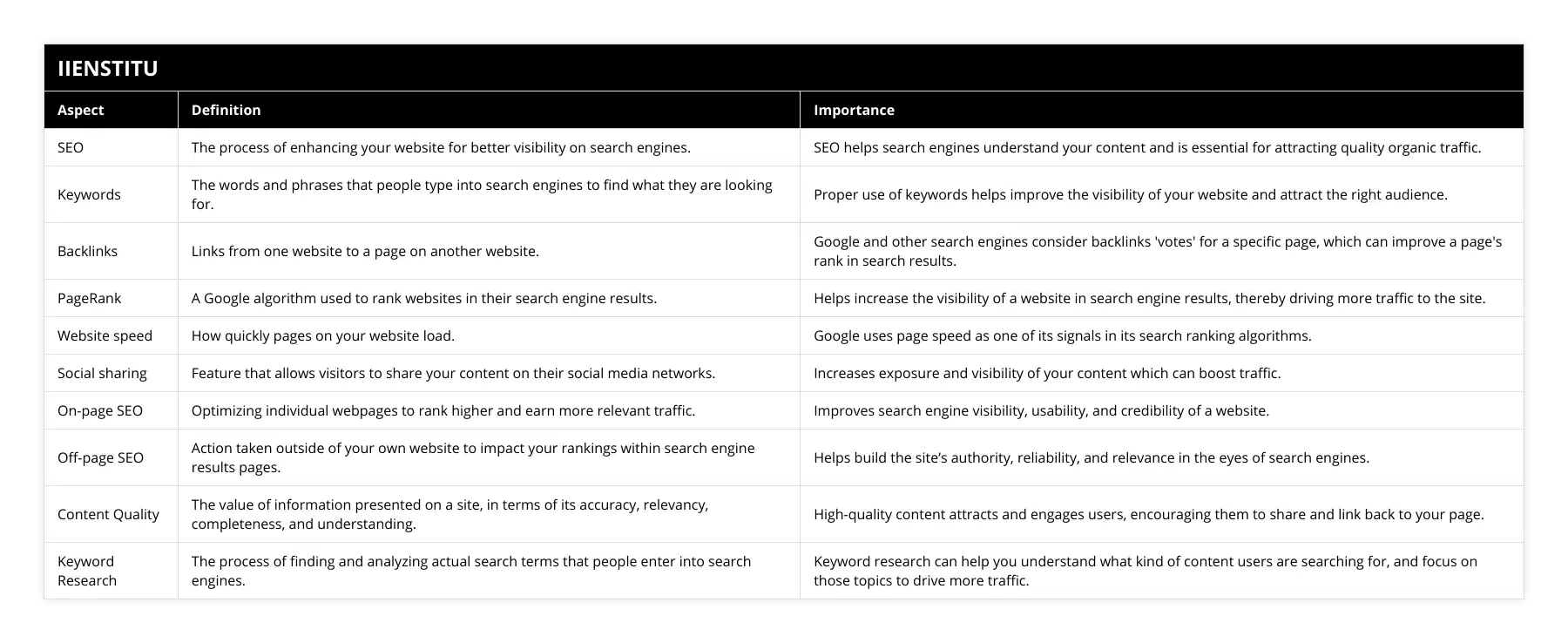
Frequently Asked Questions
What are the key factors that contribute to climate change?
Key Factors Contributing to Climate Change
There are several key factors that contribute significantly to climate change. The most significant is the burning of fossil fuels such as coal, oil and natural gas. When fossil fuels are burned, they release greenhouse gases like carbon dioxide and methane into the atmosphere. These greenhouse gases trap heat from the sun, causing global temperatures to rise.
Deforestation is another major factor. Trees absorb and store carbon dioxide. When forests are cleared, that stored carbon is released. Deforestation also reduces the number of trees available to remove carbon dioxide from the air. Between 2015 and 2020, the world lost over 4 million hectares of forest per year.
Intensive livestock farming generates significant greenhouse gas emissions. Cows and sheep produce methane as part of their digestive process. Large scale cattle ranching leads to deforestation too. The livestock sector accounts for around 15% of global emissions.
Other contributors are fertilizers containing nitrogen and the burning of biomass. Overall, human activities are responsible for almost all of the increase in greenhouse gases over the last century. To mitigate climate change, we must transition from fossil fuels to renewable energy and prevent further deforestation. We must also reduce emissions from agriculture and other sources.
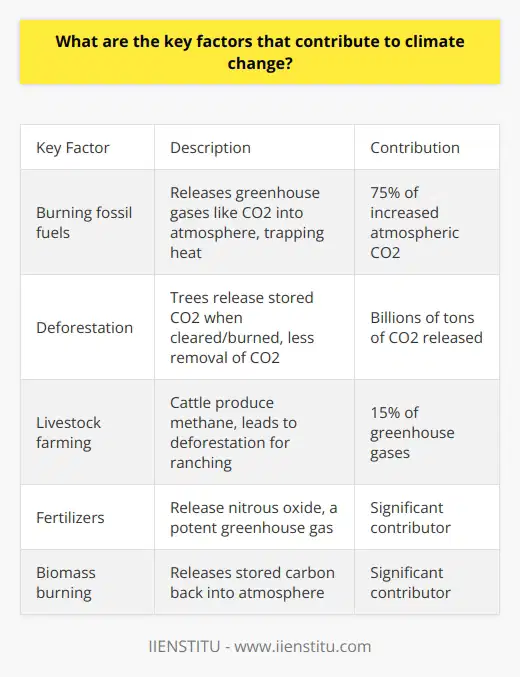
How does gender inequality manifest in different cultures?
Manifestations of Gender Inequality
Gender inequality refers to unequal treatment or perceptions of individuals based on their gender. This manifests in various ways across cultures. In many cultures, traditional gender roles cast women as caregivers and men as leaders. This leads to inequalities in domestic duties, employment, and positions of authority. For example, in parts of South Asia, women spend much more time on unpaid domestic work than men. In Saudi Arabia, strict laws prohibit women from traveling or working without a male guardian's permission.
Gender discrimination in education also perpetuates inequality. In Afghanistan, girls face barriers to attending school including lack of facilities, child marriage, and Taliban restrictions. Only 37% of Afghan girls complete primary education, compared to 66% of boys. This lack of education limits women's ability to participate in society.
Violence against women is another manifestation of gender inequality. Practices like female genital mutilation in parts of Africa, acid attacks in Southeast Asia, and honor killings in the Middle East target and control women. Up to 38% of murders of women worldwide are committed by intimate partners. Laws and enforcement often fail to protect women.
While many cultures have embedded gender inequalities, increased education for women and girls, activism, and legal protections are working to promote equal rights. Achieving gender equality requires changing long-held biases and practices.
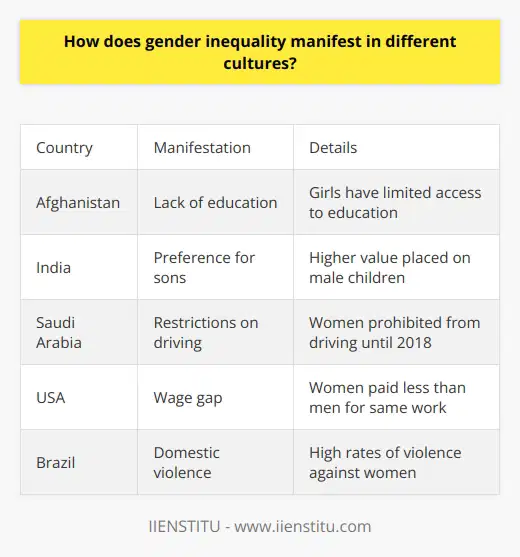
What policies can governments implement to reduce poverty?
Policies to Reduce Poverty
Governments can implement several policies to help reduce poverty. One important policy is to increase access to education. Governments can make primary and secondary education free and compulsory. They can also provide subsidies and scholarships to help low-income students attend college or vocational schools. Education gives people the skills needed to obtain better-paying jobs.
Another policy is to create more jobs and improve wages. Governments can invest in infrastructure and green technology to create construction and manufacturing jobs. They can set higher minimum wages and strengthen unions to improve pay. Policies that support small businesses can also lead to more job creation.
Governments can also strengthen social safety net programs. They can provide cash assistance, food stamps, and housing vouchers to help families meet their basic needs. Healthcare subsidies can make insurance more affordable. Increasing funding for childcare, disability, and unemployment benefits further aids those struggling financially.
Lastly, governments can reform tax policies to ease the burden on lower-income households. They can make tax systems more progressive by increasing taxes on the wealthy. Tax credits like the Earned Income Tax Credit can supplement wages for workers. Reducing regressive payroll and sales taxes helps increase take-home pay.
Implementing a mix of education, job creation, safety net, and tax reform policies can significantly reduce poverty. A comprehensive approach addresses both the symptoms and root causes of financial hardship for low-income families and individuals.
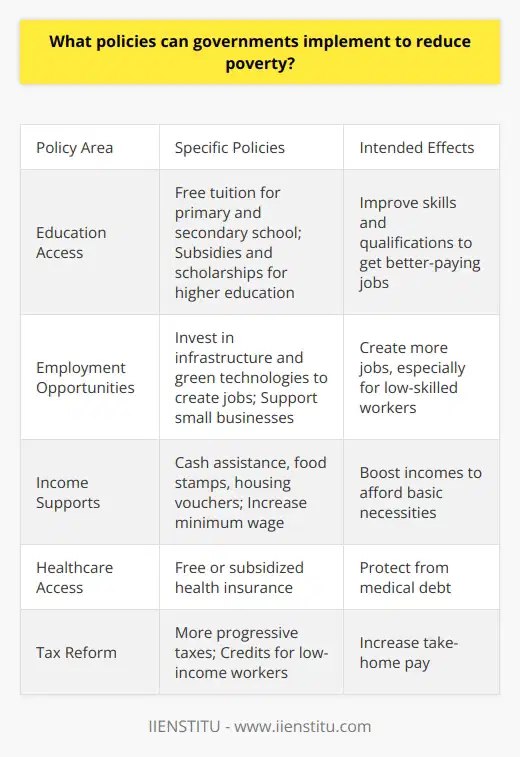
What is SEO in digital marketing
What is SEO?SEO stands for search engine optimization. It refers to strategies and techniques used to improve the ranking and visibility of a website in search engine results pages (SERPs). The goal of SEO is to make a website appear higher in search results for relevant keywords and phrases, so it gets more organic or unpaid traffic from search engines like Google.
Some important SEO techniques include:<ul> <li>Keyword research to identify relevant terms and phrases that users search for.</li> <li>On-page optimization like meta tags, headings, content, etc.</li> <li>Building high-quality backlinks from other websites.</li> <li>Improving website speed and performance.</li> <li>Creating shareable content that users want to link to.</li></ul>
Importance of SEO in Digital MarketingSEO is crucial for digital marketing success because:<ul><li>Majority of web traffic comes from organic search.</li> <li>Good SEO rankings boost brand visibility and authority.</li><li>Higher rankings drive qualified website traffic.</li><li>SEO creates more sales and conversion opportunities.</li></ul>Without SEO, potential customers won't be able to find a business online.
SEO Best PracticesSome best practices for effective SEO include:<ul><li>Optimizing website for mobile users.</li><li>Improving site speed and performance.</li> <li>Regularly creating and updating unique, useful content.</li><li>Getting backlinks from authority websites.</li><li>Leveraging social media to increase engagement.</li><li>Monitoring rankings and tweaking efforts accordingly.</li></ul>Following SEO best practices improves search visibility and traffic over time.
In summary, SEO is the process of improving a website's organic search rankings by making it easy for search engines to crawl, index, and understand website content. SEO is essential for digital marketing success in driving qualified traffic, leads, and sales from search engines. Using keyword research, optimizing on-page elements, building backlinks, and leveraging social media are some best practices for effective SEO.
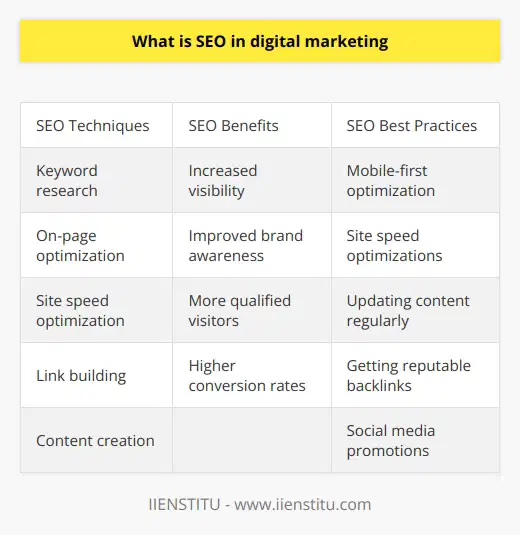
How can SEO help a business grow online
Introduction
On-Page Optimization
Off-Page Optimization
Technical SEO
Local SEO
Conversion Optimization
Conclusion

What are some best practices for optimizing a website for SEO?
Keyword Research<br>Conducting thorough keyword research is one of the most important best practices for optimizing a website for search engine optimization (SEO). This involves identifying high-traffic keywords and phrases that are relevant to the website's content and business. The keywords should then be incorporated naturally into page titles, headers, content, image names, alt text, meta descriptions, and URLs across the site. Using keywords that drive substantial search volume can help pages rank higher and attract more organic traffic.
Optimize Page Speed<br> Improving website speed is critical for SEO, as pages with faster load times tend to perform better in search results. There are various ways to optimize page speed, such as minifying code, compressing images, reducing HTTP requests, implementing browser caching, and using a content delivery network (CDN). Faster page speeds enhance user experience and lead to lower bounce rates, which search engines factor into rankings.
Mobile Optimization<br>With more and more users accessing the web via mobile devices, having a mobile-friendly website is essential for SEO in today's landscape. This includes using a responsive design, serving properly sized images, and minimizing interstitials and pop-ups. Testing the website on actual mobile devices instead of just resizing browser windows is important. Mobile optimization provides better usability for smartphone users and can bolster rankings.
Quality Backlinks<br>Building high-quality backlinks from reputable external websites helps demonstrate a site's authority on a topic and improves SEO. Guest posting on industry blogs, getting mentioned in mainstream media, and other organic link building tactics are preferable to low-quality links from spammy networks. Links should ideally include targeted anchor text and come from sites with high domain authority. Securing backlinks to inner pages can also help with overall search visibility.
On-Page Optimization<br>Properly optimizing on-page elements is key for SEO success. This includes using keywords in titles, headers, meta descriptions, image alt text, and URL structures. Content should be high-quality, unique, and provide value for users. Optimizing page titles and meta descriptions helps click-through-rates from search results. Internal links between relevant pages passes "link juice" around the site. On-page optimization demonstrates relevance to search engines.
Site Architecture<br> A properly structured website with a clear information architecture and navigation scheme helps search engines crawl and index pages more efficiently. This includes using descriptive page titles, establishing site hierarchy through XML sitemaps, implementing breadcrumb navigation, and providing easy access to high-priority pages from the homepage and site menu. Good site architecture enhances the user experience while also benefiting SEO.
Analytics and Tracking<br>Using analytics platforms like Google Analytics to monitor website traffic and user behavior provides valuable insights that can inform SEO strategy. Tracking key metrics like organic traffic, rankings, click-through rates, bounce rates, and conversion rates over time enables data-driven optimization decisions. Analytics help identify high-traffic landing pages as well as underperforming content to improve.
Content Creation and Promotion<br> Regularly publishing fresh, high-quality content on a website provides search engines with new pages to crawl, index, and potentially rank. Promoting new content through social media, email newsletters, and other channels helps drive traffic. Search engines favor websites with frequently updated content that receives engagement. An active blog or resources section demonstrates expertise in a topic area.

What is SEO and what should be considered when optimizing a website for search engines?
What is SEO?Search engine optimization (SEO) is the process of improving a website's visibility in search engine results pages (SERPs). The goal is to have a website appear higher in the rankings for relevant searches so it can be easily found by searchers. There are many factors that influence search engine rankings, but generally SEO focuses on optimizing on-page content, website technical structure, backlinks, and authority.
On-Page OptimizationOn-page optimization refers to optimizing the content and code directly on a web page. This includes optimizing page titles, headings, content, URL structure, image alt text, site speed, and more. Key on-page factors include using relevant keywords in content, creating unique and useful content, improving site architecture and navigation, and ensuring a positive user experience. The goal is to make pages easy for search engines to understand and relevant for search queries.
Technical SEOTechnical SEO involves optimizing the behind-the-scenes technical elements of a website. This includes ensuring proper website crawlability, indexation, and rendering. Technical optimization focuses on site speed, mobile friendliness, proper URL redirects, XML sitemaps, robot.txt files, structured data markup, and more. Proper technical SEO creates a website architecture that search engines can easily crawl and understand.
Link BuildingLink building refers to efforts to acquire backlinks from other websites in order to improve search rankings. High quality backlinks from relevant websites help demonstrate authority and relevance. Link building techniques include outreach for backlink placement, creating shareworthy content, guest posting, infographics, and more. The focus should be on acquiring editorial links versus paid links.
Authority and Trust Authority and trust are important ranking factors for search engines. Websites that are seen as more reputable and trustworthy tend to perform better. Authority is built through high quality content, expertise, positive user experience, and brand recognition. Trust comes from security features, positive reviews, citation sources, and transparency. Optimizing for authority helps validate a website's relevance.
In summary, effective SEO requires a focus on on-page content, website architecture, backlink acquisition, authority building, and creating a positive user experience. This improves visibility and traffic from organic search. SEO is an ongoing process as search engine algorithms evolve over time.
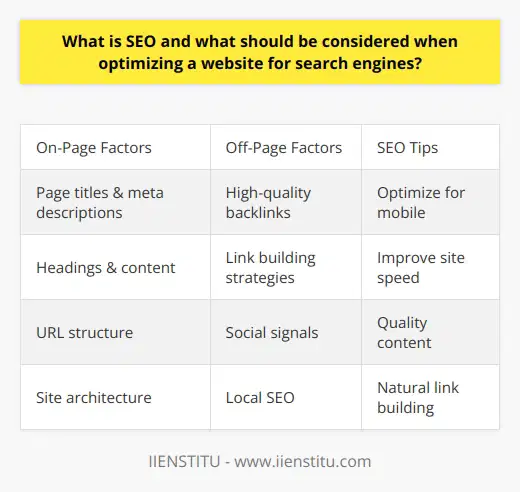
What factors should be considered when trying to improve a website's search engine optimization?
On-Page Optimization
Technical Optimization
Off-Page Optimization
User Experience
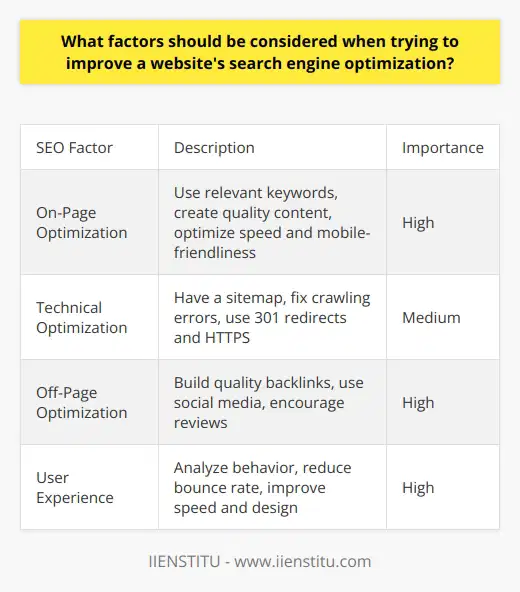
What does SEO stand for and what are some best practices for optimizing web pages and sites for search engines?
What is SEO?SEO stands for search engine optimization. It refers to strategies and techniques used to improve the ranking and visibility of a website in search engine results pages (SERPs). The goal of SEO is to help websites rank higher for relevant keywords so they can be easily found by searchers.
On-Page SEOOn-page SEO refers to optimizations made directly on the webpages of a site. Some key on-page factors include:
Using keywords in titles, headers, content, image names, alt text, etc.
Optimizing page speed and mobile friendliness
Improving website navigation and internal linking
Adding schema.org markup for rich snippets
Creating unique, high-quality content that answers search queries
Keyword research should inform what terms are used on-page. Focus on a few primary keywords per page. Use them in titles, headers, image names, URLs, etc. But avoid over-optimization. Content should be written for users.
Off-Page SEO Off-page SEO refers to factors external to the website itself. Some key off-page techniques include:
Link building from high-quality websites
Leveraging social media for shares and links
Securing branded mentions and backlinks
Building localized citations and reviews
Creating linkworthy, shareworthy content
Link building is crucial for SEO. Focus on earning links from reputable websites, especially sites ranking for your target keywords. Prioritize contextual, editorial links. Avoid low-quality links from spammy networks.
Technical SEOTechnical SEO ensures search engines can easily crawl, index, and understand your site. This includes:
Optimizing site architecture with a sitemap and internal linking
Ensuring proper use of redirects and canonical tags
Optimizing page speed and mobile experience
Fixing broken links and 404 errors
Implementing structured data markup
Technical SEO establishes the proper site infrastructure for search engine accessibility and visibility. This makes on-page and off-page optimizations more effective.
In summary, core SEO best practices include keyword optimization, high-quality content, link building, social sharing, speed enhancements, mobile optimization, and proper website infrastructure. SEO is an ongoing process, requiring regular analysis and improvements to boost search visibility over time.
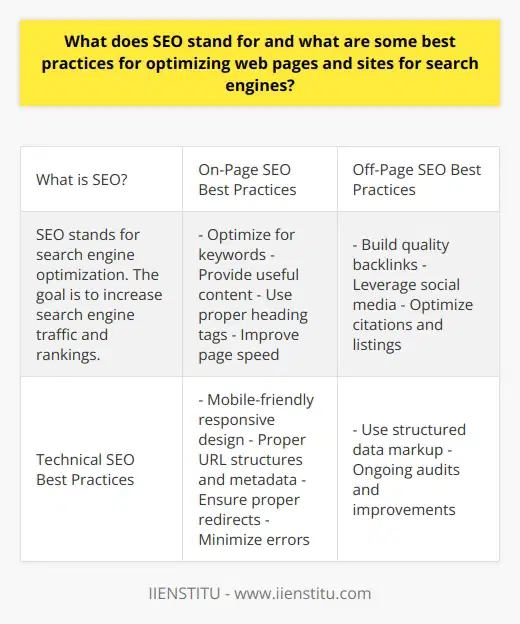
What is the definition of SEO and what are some common examples?
What is SEO?
Search engine optimization (SEO) refers to the process of improving a website's visibility in search engine results pages (SERPs). The goal of SEO is to help a website rank higher in search engines like Google, Bing, and Yahoo when users search for related keywords and phrases. This allows the website to get more organic or unpaid traffic from search engines.
SEO involves both on-page and off-page optimization tactics. On-page SEO refers to optimizing elements directly on the website, such as page titles, meta descriptions, headings, content, image alt text, site architecture, URL structure, etc. Off-page SEO refers to building links and generating social signals to improve a site's authority and relevance. Overall, SEO helps make a website more findable, crawlable, and engaging to both search engines and users.
Common Examples of SEO
Here are some common SEO practices and examples:
- Keyword research - Identifying high-value keywords and phrases that relate to the business to optimize for. For example, a shoe company would target keywords like "buy shoes online" or "athletic shoes for women".
- On-page optimization - Crafting page titles, meta descriptions, headings, content, etc. around target keywords to help search engines understand the topic and content of each page. For example, using "athletic shoes for women" in the page title and headings.
- Internal linking - Linking related pages together using anchor text keywords to help search engines crawl and index the site. For example, linking product pages to category pages with keywords.
- Content creation - Publishing blog posts, articles, guides, etc. that focus on specific keywords and answer user search queries. For example, "guide to buying running shoes".
- Link building - Earning links from other authoritative sites to increase referral traffic and signal to search engines that the site is trustworthy. For example, getting links from review websites or industry publications.
- Social media marketing - Promoting content on social media to generate clicks, shares, links, and increase visibility. For example, sharing blog posts on Twitter and LinkedIn.
- Mobile optimization - Ensuring site design and content are optimized for mobile devices and smartphones. For example, using a responsive web design.
In summary, SEO is the process of making a website more visible in search engine results through both technical and marketing tactics. Common examples include keyword optimization, content creation, link building, and leveraging social media to promote a website. The goal is to attract more organic search traffic by ranking higher for relevant user queries.
What are the main goals and techniques of SEO?
Search engine optimization (SEO) refers to the process of improving a website's visibility in search engine results pages (SERPs). The main goals of SEO are to increase a website's organic traffic, improve rankings for target keywords, and boost conversions. There are various techniques used in SEO to achieve these goals.
On-Page Optimization
On-page optimization focuses on optimizing individual webpages to improve their rankings. Some key on-page techniques include:
Keyword research - Identifying high-volume, low-competition keywords that are relevant to the content.
Optimizing page titles and meta descriptions - Including keywords in succinct, compelling page titles and meta descriptions.
Content optimization - Creating content that answers user queries and incorporates target keywords naturally.
Image optimization - Adding descriptive filenames, alt text, title tags to images.
Internal linking - Linking to other relevant pages on your site to pass link juice.
Optimizing page speed - Minifying code, compressing images, caching to improve page load times.
Off-Page Optimization
Off-page optimization focuses on building high-quality backlinks from external websites to improve domain authority and rankings. Some key off-page techniques include:
Link building - Reaching out to relevant websites to earn backlinks naturally.
Guest posting - Creating content for other blogs in your industry to get backlinks.
Broken link building - Replacing broken links on other sites with links to your content.
Social media marketing - Leveraging social media to generate links and increase brand visibility.
Local SEO - Optimizing online profiles on directories and citation sites.
Technical SEO
Technical SEO focuses on the behind-the-scenes technical health of a website. Some important aspects include:
Optimizing site architecture - Creating a logical, easy-to-navigate site structure.
Ensuring mobile responsiveness - Making sure site displays well on mobile devices.
Fixing 404 errors - Identifying and correcting broken pages and links.
Improving site speed - Reducing page load times through various performance optimizations.
Using structured data - Adding schema markup to enhance how search engines understand page content.
By focusing on these core SEO goals and techniques, websites can improve their visibility, attract more organic traffic from search engines, and ultimately boost conversions and revenue.
How can SEO help a business or website improve its online visibility and traffic?
Importance of SEO
Search engine optimization (SEO) is very important for businesses and websites looking to improve their online visibility and increase traffic. SEO refers to strategies and techniques used to help a website rank higher in search engine results pages (SERPs). Higher rankings lead to increased visibility, more website visitors, and higher conversion rates.
How SEO Works
SEO works by optimizing a website so it will rank higher in search engines like Google and Bing. This is done by improving technical elements like website speed, optimizing content for keywords, building high-quality backlinks, and providing a good user experience. The goal is to make a website more relevant for specific keyword searches.
On-Page Optimization
On-page optimization refers to changes made directly on a website page to improve SEO. This includes optimizing page titles and meta descriptions to include keywords, using keywords naturally throughout content, improving website speed, implementing responsive design, and structuring pages effectively. On-page optimization makes it easier for search engines to crawl, index, and understand website content.
Off-Page Optimization
Off-page optimization refers to actions taken outside of a website to improve its SEO. A major off-page factor is link-building, which means getting high-quality websites to link back to your site. Other off-page factors include social media engagement, local listings, reviews, and brand mentions. Off-page optimization helps demonstrate a website's authority and relevance.
Tracking and Monitoring
It is important to track and monitor SEO efforts over time. Tools like Google Analytics and Search Console provide data on website traffic sources, top landing pages, keyword rankings, and more. SEO is an ongoing process, so continuously evaluating results and making adjustments is key for long-term success.
SEO Benefits
Investing in SEO provides many benefits for businesses and websites. Higher rankings lead to increased website traffic and visibility. More traffic means more potential customers and higher conversion rates. Good SEO also boosts brand awareness and establishes credibility and authority. Overall, SEO is a smart digital marketing strategy for improving online presence.
How to do SEO
Keyword Research
Optimize Title Tag
Meta Description
Content Optimization
Image Optimization
Internal Linking
External Linking
Technical SEO
What are the best practices for SEO
Keyword Research
Optimize Title Tags
Meta Descriptions
Heading Tags
Image Optimization
Internal Linking
Quality Content
What factors affect search engine rankings?
KeywordsKeywords are one of the most important factors for search engine optimization (SEO). The keywords used on a webpage and throughout the content need to be relevant to what the page is about. Using keywords appropriately helps search engines understand the topic of the page. Keywords should be used in titles, headers, meta descriptions, image alt text, URLs, and within the body content. The keywords should be used naturally within the copy and not stuffed just for SEO purposes. Using the same keyword multiple times can improve rankings.
Quality ContentHigh quality, useful content is essential for good SEO and rankings. Search engines want to provide the most relevant, helpful content to searchers. Unique, original content that provides value to users will perform better than duplicate or auto-generated content. Content should be well-researched, accurate, and comprehensive on the topic. High quality content leads to more engagement like social shares, links, and lower bounce rates, which all help with rankings.
Page SpeedThe speed at which a webpage loads affects search engine rankings. Pages that load quickly perform better than slow loading pages. Fast page speeds lead to better user experience. To improve page speed, compress images, minify CSS and JavaScript files, enable caching, optimize code, and use a content delivery network (CDN). Mobile page speed is especially important as mobile usage grows. Optimizing page speed should be a priority.
User SignalsUser engagement signals like click-through-rate, time on site, and pages per session are factored into search rankings. Content that keeps users on the site and website features that enhance user experience can improve rankings. User signals show search engines that content is useful and valuable. Encouraging social shares, links, and return visits from users also boosts rankings through increased user signals.
Backlinks Getting quality backlinks from other authoritative websites to your site is very important for SEO. Search engines view backlinks as votes of confidence. The more quality backlinks from reputable sites, the higher a page will rank in search results. Building backlinks should be done through content marketing, outreach, guest posting, etc. Unnatural link building tactics can negatively impact rankings. Focus on earning backlinks from high authority sites in a relevant niche.
What are the different types of SEO in digital marketing?
Search engine optimization (SEO) is an important part of any digital marketing strategy. The goal of SEO is to improve the ranking of a website in search engine results pages (SERPs) for relevant keywords and phrases. There are several different types of SEO that can be utilized as part of an overall SEO strategy.
On-Page SEO
On-page SEO refers to optimizations made directly on a website. This includes optimizing page titles, meta descriptions, headings, content, image alt text, site architecture, internal links, URL structure, page speed, and more. The goal is to help search engines better understand the topic and content of each page.
Off-Page SEO
Off-page SEO refers to efforts made outside of a website to improve its rankings. A major off-page SEO tactic is link building, which involves earning high-quality backlinks from other relevant websites. Other off-page efforts include social media marketing, local SEO, optimizing citations, and monitoring online mentions.
Technical SEO
Technical SEO focuses on the behind-the-scenes technical health of a website. This includes optimizing site architecture, enhancing page speed, improving website security, fixing broken links, improving code quality, and ensuring proper indexing by search engines. Technical SEO establishes the foundation for other SEO efforts.
Local SEO
Local SEO is about optimizing a website for local search visibility. This may involve optimizing business name, address, and phone number, building local links and citations, encouraging customer reviews, creating location pages, and using schema markup. The goal is to improve local search rankings and be discoverable by nearby customers.
Mobile SEO
With more and more searches happening on mobile devices, mobile SEO is critical. This may involve optimizing for mobile indexing, creating a mobile site/pages, reducing page load times, using responsive web design, and tailoring content for mobile users. The goal is delivering a seamless experience for mobile searchers.
By utilizing a combination of these SEO types and techniques, businesses can develop a comprehensive strategy to improve organic search visibility, traffic, and conversions. However, SEO is an ongoing process that requires continuous optimization and adaptation to algorithm changes over time.
How can understanding the types of SEO help with digital marketing strategy?
How Understanding Types of SEO Can Help Digital Marketing Strategy
Search engine optimization (SEO) is a crucial part of any digital marketing strategy. There are two main types of SEO that marketers need to understand - on-page and off-page SEO. Knowing the differences between these types of SEO and how to utilize them can greatly improve a company's visibility and traffic from search engines.
On-Page SEO
On-page SEO refers to optimizations made directly on a website. This includes optimizing page titles, meta descriptions, headings, image alt text, site speed, internal links, URL structure, and content. On-page SEO helps search engines understand what a page is about so they can determine relevancy for search queries. Some key on-page optimization tips include:
Use targeted keywords in titles, headers, meta descriptions, alt text
Create unique, SEO-friendly page URLs
Optimize page load speed by minifying code, compressing images, and eliminating render-blocking resources
Include outbound links to reputable external sources to boost credibility
Write high-quality content that answers searchers' queries
Off-Page SEO
Off-page SEO refers to actions taken outside of a website to improve its rankings. This includes link-building, social media marketing, brand mentions, and other external signals to search engines. High-quality backlinks from reputable websites are one of the most important off-page ranking factors. Other off-page optimization tips:
Build backlinks from high authority sites related to your industry
Be active on social media and optimize profiles with keywords
Publish guest posts on popular blogs and sites to gain backlinks
Distribute content on platforms like Medium to increase domain authority
Engage influencers and partners to mention your brand
By understanding both on-page and off-page SEO techniques, digital marketers can develop an effective strategy. Optimizing for search early on and continuously maintaining best practices for both types of SEO will improve organic visibility and traffic over time.


